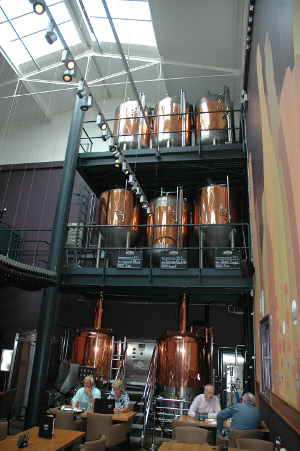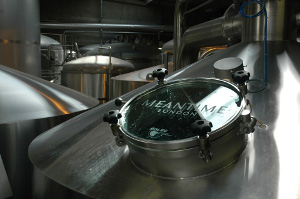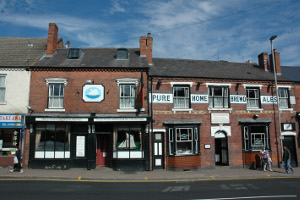
So many breweries, so little time
At present there are somewhat more than one thousand breweries in operation in the United Kingdom, probably more than anyone but a dedicated and well-funded enthusiast could visit in a lifetime. The number reached one thousand in 2012, after having doubled in the previous decade, and quadrupled since the early 1970s. Being recently in the mother country for a few weeks for purposes completely unrelated to the drinking of beer, I nevertheless seized all available opportunities to do so, including at eleven breweries.
Apart from a strong pre-departure determination to visit three particular English beer-making sites, most of my brewery visits were either unplanned or loosely planned (i.e. they were dependent on my happening to be in the right place and having sufficient spare time). The particular breweries were Fuller’s at Chiswick, Meantime at Greenwich, and the Old Swan at Netherton. Through careful prior research into other possibilities, combined with pure serendipity, brief visits to a further eight breweries were also achieved. Without trying very hard, the products (mostly cask ales, by preference) of a further thirty-six UK breweries, including nine in Scotland, were also consumed in various pubs and restaurants along the way, but no more will be said here about them.

An antique brewing copper at Fuller’s, installed in 1823 and last used in 1984.
I intend to focus this commentary on just four of the visited breweries, but it would be unfair not to at least mention the other seven. Brew Wharf is a microbrewery with a bar and restaurant, situated in the bustling Borough Market, one of the largest wholesale and retail food markets in London. It opened in 2005. The Lamb Brewery, which opened in 2012, is situated in the former Barley Mow pub at Chiswick in west London. It takes its name from the Lamb Brewery which operated nearby until the 1920s. The Camden Town Brewery and its associated brewery tap occupy the space within a row of railway arches directly beneath the Kentish Town West Railway Station in north London. Although opened as recently as 2010, and despite its cramped accommodation, it is now the third biggest brewery in London, after Fuller’s and Meantime. Brodie’s Brewery is attached to the William IV, a traditional pub at cosmopolitan Leyton in east London, and has been in operation since 2008.
Beyond London, the York Brewery is the only brewery in operation within the walls of the city of York. It started production in 1996, and now owns five pubs (four in York and one in Leeds). The brewery has a tap room, and operates popular guided tours. The Leeds Brewery, established on the outskirts of that city in 2007, has a separate Brewery Tap in the centre of the city. It opened in 2008, and has its own upstairs microbrewery. The main Leeds Brewery, despite having only a 20-barrel plant, became the biggest in the city when the big old (1822) Tetley’s brewery was closed in 2011. At Kirkcaldy, on the northern shore of the Firth of Forth, the waterfront Harbour Bar is the home of the Fyfe Brewing Company, which has operated a microbrewery at the back of the pub since 1995. Alas, brewing was in recess when I visited, but ales from other Scottish breweries were still to be had. I appreciate that it is arguable whether, under these circumstances, this qualifies as an actual brewery visit, but I am claiming it as such.

Three-tiered microbrewery at Meantime’s The Old Brewery, Greenwich.
The four remaining breweries are representative of both the traditional and the modern faces of brewing in the United Kingdom today. The largest and oldest is Fuller’s, on the northern side of the Thames at Chiswick. A brewery has operated on this site for some 350 years, and members of the Fuller family have been involved since 1829. A guided tour of the brewery, followed by a generous tasting session, costs ten pounds, and is worth every penny. This is a modern brewery, fitted with the most up-to-date equipment, but various pieces of old kit, such as a square, copper-lined, open fermentation vessel, and an ancient disused copper (pictured), have been retained for their historical interest. The post-tour tasting session covered most of the brewery’s product range, including Horndean Special Bitter (HSB), inherited from George Gale when Fullers took over that old Hampshire business in 2005. Although Fuller’s produces dozens of different regular and occasional brews, 80 per cent of the output of the brewery is accounted for by just one of them—its famous London Pride.
Next in size, though not in age, is the Meantime Brewery (pictured). Meantime was established in a small way in 2000 at Charlton, and did most of its early business designing and making beers for others, including the Sainsbury supermarket chain. It refocussed on its own Meantime-branded beers from 2005, and grew so spectacularly that a move to larger premises, at adjoining North Greenwich, was necessary in 2010. More recently, the capacity of the new brewery has been quadrupled, and it is now the second largest in London, after Fuller’s.

In the modern brewhouse at Meantime Brewery, North Greenwich.
There is necessarily little of historical interest in such a modern brewery, but its new visitors’ centre compensates to a great extent with its display of bottles of beer from around the world, part of the vast collection assembled by Michael Jackson, and given to Meantime founder Alastair Hook after the beer guru’s death in August 2007. The display provides a fitting backdrop for the post-tour tasting session, which encompasses several substantial samples of various Meantime beers. The basic tour here cost 15 pounds, more than at Fuller’s, but still good value. At both places I was struck by the relative freedom with which visitors are allowed to wander around and commune with the equipment, and also with the liberality of the product samplings; a far cry from the hand-holding and nannying that have come typify industrial tours in Australia.
Like the Leeds Brewery, Meantime also operates a subsidiary microbrewery at a separate site (pictured). Meantime’s is at the Old Royal Naval College, about a mile west of the main brewery site. I’m sorry about the unit of measure, but more than two thousand miles of driving around England and Scotland in two weeks has temporarily converted me back to the Imperial system. One thing that makes Meantime’s microbrewery very special is the fact that it is housed in a building that once was used to make beer for naval purposes.
The Royal Naval College was established in buildings originally erected as a hospital for old and injured seamen. The hospital was a project of Queen Mary, the consort of William III, but Mary died in December 1694, before construction was begun. Mary’s project was continued and carried into effect by William, and was so far completed by the beginning of 1705 that a small number of pensioners had by then been admitted. The number had increased to one thousand by 1738, and later peaked at around three thousand.

The Old Swan Inn, also known as Ma Pardoe’s, at Netherton, West Midlands
Each of these naval pensioners was given a weekly allowance of food, including 14 quarts of beer (a bit more than two litres per day). A brewery was established at the hospital to supply the allocation of beer. It seems to have come into production in 1717, in response to recurring quality problems with beer supplied previously from off-site. The brewery was rebuilt in a more modern form, with a steam engine, in the early 1830s, but was destroyed by fire in 1843. It was restored, but ceased to operate with the closure of the hospital in the 1860s.
An Act of Parliament in 1865 improved the arrangements for out-pensioners, and offered inducements to inmates of the hospital to retire from it and live off-site. Nearly one thousand of the 1,400 in-pensioners then elected to leave. A second Act, in 1869, accomplished the final clearance of the site, eliminating the need for the brewery. The hospital remained closed and unused until it was reopened in 1873 as the Royal Naval College for the education of naval officers, who presumably had to buy their own beer.
The Navy left the site in 1998, and since then the buildings have been used for various other purposes, under the overall management of the Greenwich Foundation. Meantime’s Alastair Hook did a deal with the Foundation in 2008 to recommence brewing on the site of the original brewery, and The Old Brewery cafe, restaurant, bar and microbrewery opened for business in 2010. It purveys a wide range of Meantime beers, including some limited editions brewed on-site in small (800 litre) batches, as well as many beers from other breweries.
Lastly, but in no way least, a visit was made to the Old Swan Inn and Brewery at Netherton, near Birmingham. This was more of a pilgrimage that a mere visit, for the Old Swan occupies a very special place in the history of brewing. Of the thousands of brewpubs that operated throughout England in the nineteenth century, it is one of only four to have survived beyond 1970. The others are the All Nations and the Three Tuns, both in Shropshire, and the Blue Anchor in Cornwall.
The Old Swan is better known as Ma Pardoe’s, after Doris Pardoe, a former landlady. Doris and her husband, Fred, ran the pub and brewery from 1931 until his death in 1952, after which Doris continued it until her demise in 1984. It was carried on briefly by their daughter, Brenda, then in 1985 it was purchased by Netherton Ales, a company largely owned by the Campaign for Real Ale (CAMRA), who wished to secure the future of the historic site. After extending the pub into the adjoining shop (left in the picture), Netherton Ales sold out in 1987 to Hoskins, the Leicester brewer. Wiltshire Brewing Co. took over from Hoskins in 1989.
For reasons that I doubtless would have discovered had I the time to stay for another pint, brewing ceased at the Old Swan around 1990. It was revived in 2001 by the present licensee, Timothy Newey, and has been carried on more or less continuously ever since. The brewery occupies an attached building at the rear of the pub, and operates partially on the gravitation system. A fire in 1986 destroyed most of the equipment, but the wooden mash-tun survived and continues to be used. Fermentation still takes place in open-topped vessels, true to the original scheme.
Eleven breweries being only about one per cent of the total in the United Kingdom today, I barely scratched the surface during my visit. So many breweries, so little time. Nevertheless, this tiny subset, with its overall bias towards the small and the new, revealed a great many aspects of the brewing industry and its products, so proved to be highly enlightening. It goes without saying that the experience was also decidedly pleasurable.



